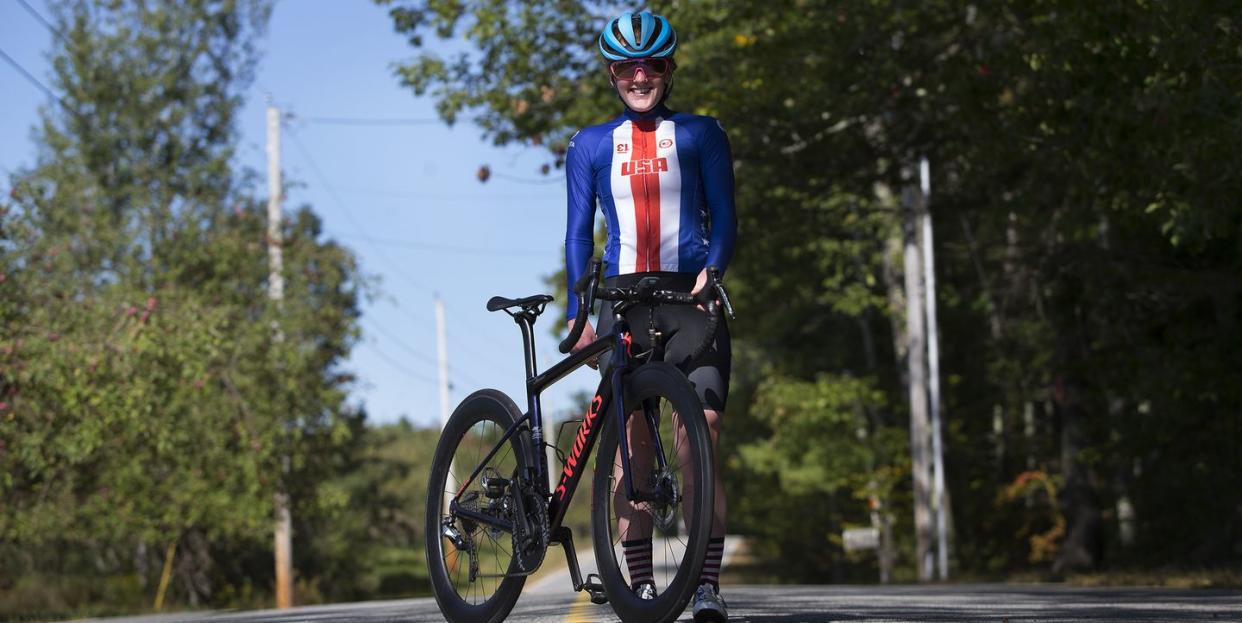While Training Full-Time for the Paralympics, Clara Brown Is Spreading the Word About Bikes

Clara Brown, a C3 athlete who races track cycling and road cycling for Team USA, is fully focused on training for the 2021 Paralympics in Tokyo this August; she qualified on the track based on her performance at the UCI Paracycling Track World Championships in early 2020, before COVID-19 halted races across the world.
But beyond training for the biggest athletic competition in the world, the two-time world champion has been thinking about how to best use her platform to help others get involved with cycling.
➡️ Want to become an even better cyclist? Join Bicycling All Access to get exclusive tips and advice! 🚲
“It was super intimidating for me [to get started], and it really took someone else to encourage me,” Brown, 25, told Bicycling. “It literally took someone saying, ‘You can do this, we can make a bike work for you.’”
When Brown was 12 years old, she crushed two vertebrae in a gymnastics accident and was initially paralyzed from the neck down. Thinking her athletic career was over, she simply focused on regaining the ability to walk.
“I was really lucky that the injury was incomplete, meaning my spinal cord wasn’t severed, so there was always potential that I could get nerve function back below my injury,” she said. “But every case is so different that it’s hard to predict.”
Despite a number of setbacks, Brown persevered. She tapped into her competitive nature and knew that she still wanted to be an athlete, but she needed some encouragement. When a friend suggested she modify a bike so that she could control the brakes and gearing all on one side, in order to accommodate the permanent nerve damage from her injury, she was intrigued. They put a brake splitter so that one brake lever goes to both brakes, and adjusted the shifting so it’s all controlled on the left side. Brown also uses a much shorter crank.
“Building a bike with my specific needs in mind was such a game-changer,” Brown said. “When you look at my bike it looks pretty normal, and I just had a few tweaks that changed everything, so that I can control the whole bike with my left side. But for a long time I had no idea that was even an option.”
Brown wants to be that voice for others, who may need the encouragement, or who may not even know that bikes can be modified for different bodies.
“Bikes should be more accessible to more people. There’s such an intimidation with the spandex and the super lightweight aero everything. And that has its place, but that’s not the entire cycling community.”

Recently, Brown was named an ambassador for Outride, an organization that provides children with cycling programs to improve social, emotional, and cognitive health. The concept behind Outride is based on research that shows that kids (and people of all ages), especially those with ADHD, function at a much higher level when exposed to outdoor activity.
Through Outride, Brown has been able to work toward her goal of spreading the word about cycling. At the beginning of March, Brown, along with another Outride ambassador, Michael Osei-Ampadu, had the opportunity to virtually visit AIM Academy, a college preparatory school for children with language-based learning differences in Conshohocken PA. AIM has used the Riding for Focus Program—a middle school-based physical education program that is part of Outride—for the last five years.
Brown said some of the students were in a classroom setting together, and some were calling in from home, but that everyone was excited to hear about her experiences riding bikes.
“It’s hard because you want to connect with kids in person—I think we’re all sick of screens at this point,” Brown said. “But it was really great because Michael and I have two totally different stories. He grew up in Germany and got into bike riding by commuting because his parents didn’t have a car, and has raced some but never really made that a career path. So it was a nice juxtaposition with me and my spandex race experience. It was fun to field the questions with two different perspectives on bike riding.”
Brown said that she and Osei-Ampadu also took questions from the students—“everything from what’s my favorite ice cream flavor [chocolate chip cookie dough] to what’s it like to be a woman cyclist and a para athlete.”

Brown wants to visit more schools, especially in-person in her community in Whitefish, Montana. “I would love to help the faculty coordinate a Riding for Focus Program somewhere locally. I would love to be a point person alongside a teacher or administrator.”
While Brown has all eyes on Tokyo right now—she’s preparing for the U.S. Paralympic Cycling World Cup event in Huntsville, Alabama, which will be her first race in more than a year—she will always keep her larger goal in mind. She wants to raise awareness of parathletes as athletes, and get more people active, no matter their body.
“I want to celebrate parathletes as athletes first and foremost and not necessarily ‘para.’ I want to be competitive on the able-bodied stage and prove that we are elite athletes. There’s this perception of ‘para’ that we’re less able, and yes, we definitely have some funkiness going on, but we’re also exceptional athletes.”
You Might Also Like

